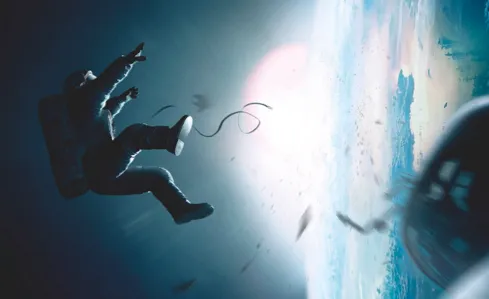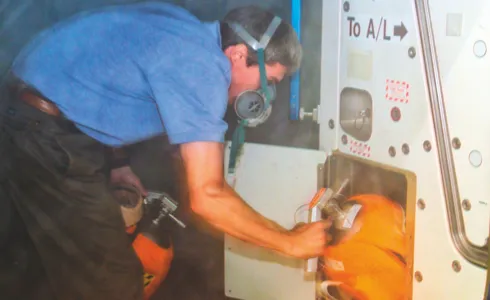Two astronauts float in space, working on the Hubble Space Telescope. Suddenly, a rogue piece of satellite crashes into the Space Shuttle that got them there. Hubble is hit by a piece of debris, too, knocking it out of its orbit. As the Shuttle is destroyed, the robotic arm that astronaut Ryan Stone is tethered to begins spinning out of control. She frantically tries to detach from it, just managing to set herself free. The Shuttle falls and Dr Stone is left floating in space, along with astronaut Matt Kowalsky. Contact with Houston is lost – the two astronauts are alone.
That’s the premise of a new film calledGravity, which will hit cinemas on 8 November, starring Sandra Bullock as medical engineer Dr Ryan Stone and George Clooney as veteran astronaut Matt Kowalsky.

Fact or fiction?
This scenario may be fiction, but how close to reality is it? Astronauts who go to space today don’t travel on the Shuttle, and it’s the International Space Station (ISS) rather than Hubble that’s the setting for today’s space walks. A satellite roughly the size of a football field, orbiting 370km (230 miles) above our heads, it would seem that the chances of a collision with a piece of space debris would be high.
Earlier this year, a meeting on space debris organised by the Inter-Agency Space Debris Coordination Committee (IADC), made up of representatives from space agencies around the world, concluded that the number of catastrophic collisions with spacecraft could soon increase to as many as one every five years. A catastrophic collision is one that results in the total breakup of the spacecraft the debris hits.
“A catastrophic collision involving the ISS is unlikely,” says Dr Hugh Lewis, an aerospace engineer at the University of Southampton and the UK Space Agency’s representative at the IADC space debris meeting. That’s because the debris would need to be huge to impart enough energy to destroy something as large as the ISS.

Although the ISS is unlikely to be destroyed by space junk, if a debris collision did leave an astronaut stranded outside the ISS on a space walk, how long they could survive “depends on the resources of the suit”, says Dr David Green of King’s College London. Spacesuits usually have about seven hours of oxygen, but that gets used up more quickly if you panic – and not panicking would be a big ask for someone stranded in the blackness of space.
InGravity, the stranded astronauts are wearing a version of NASA’s Manned Maneuvering Unit used in 1984 Shuttle missions to zip around the outside of the spacecraft. But these days, astronauts on space walks wear a smaller propulsion system that is designed for emergencies and has enough propellant for only one ‘self-rescue’ of about 13 minutes.

Evasive manoeuvres
If space debris is spotted on a collision course with the ISS, there is something that can be done. So United States Strategic Command, part of the US Department of Defense, keeps a close eye on it. It tracks all debris larger than 10cm using radar. If anything looks like it’s going to enter the area around the station, Strategic Command alerts flight controllers at NASA’s Johnson Space Center in Houston, Texas.
If the piece of space debris has a greater than 1 in 100,000 chance of colliding with the station, Houston sends instructions to the ISS computers to alter its path. The ISS has a set of four gyroscopes and thrusters that allow it to change altitude, rotate and move side to side. Its typical speed during an avoidance manoeuvre is between 0.5 and 1m/s.
If something is spotted too late to make a move, the astronauts hunker down in the Soyuz escape craft and prepare to return to Earth if necessary. The last time that happened was in 2012 – luckily, the debris, a small fragment of the Russian Kosmos-2251 satellite, missed the ISS by over 10km (6 miles).

But chunks of metal hurtling through space are not the only threat to astronauts on space walks. Given how much they rely on equipment such as spacesuits while they are outside the Earth’s protective atmosphere, malfunctions can spell big trouble.
A space walk in July this year had to be cut short when water started leaking into Italian astronaut Luca Parmitano’s spacesuit helmet. “There is some in my eyes, and some in my nose. It’s a lot of water,” Parmitano said at the time. In space, this could be deadly. Floating
water droplets could have caused Parmitano to drown. He was not hurt, but NASA convened a ‘Spacewalk Mishap Investigation Board’ to look into what happened. Early indications suggest that water from the suit’s coolant system might have been leaking out through its ventilation system.
In 2001 there was a different kind of leak. Ammonia from the Space Station’s cooling system leaked out of a valve while two astronauts were on a space walk. As he struggled to close the valve, US astronaut Robert Curbeam’s spacesuit and helmet accumulated a layer of toxic ammonia crystals an inch thick. His colleague had to brush off as much as he could, before Curbeam waited outside the Space Station for the rest to evaporate. When they returned inside, the crew wore oxygen masks while the life support system purged any remaining ammonia from the air.
Threats don’t disappear once an astronaut is safely inside the station, either. Possibly the biggest danger is fire, which behaves differently in space. “In zero gravity, the hot gases don’t go up anymore,” says Professor José Torero, an expert in fire safety aboard spacecraft at the University of Queensland. “They become a semi-sphere and they get bigger and bigger, but they don’t go anywhere.”

In 1997, a fire broke out on the Mir space station after a cosmonaut routinely ignited a canister to add oxygen to the air supply. Because of the oxygen it contained, the canister acted like a blow torch. Eventually, the fire burnt out, but not before filling the station with smoke. “They were lucky that the flames didn’t touch anything else,” says Torero.
Rather than trying to actively extinguish a fire, the trick is to make sure it runs out of fuel. These days, NASA rigorously tests all materials that go up to the Space Station. If something is flammable, astronauts know to treat it with care – their life may depend on it.
So while missions in space are now commonplace, the dangers have not subsided, and with the ever-growing threat of space junk, astronauts will need to be more vigilant than ever.
This is an extract fromBBC Focus magazine.
Subscribe and get the full article delivered to your door, or download the BBC Focus app to read it on your smartphone or tablet. Find out more
Follow Science Focus onTwitter,Facebook, Instagramand Flipboard